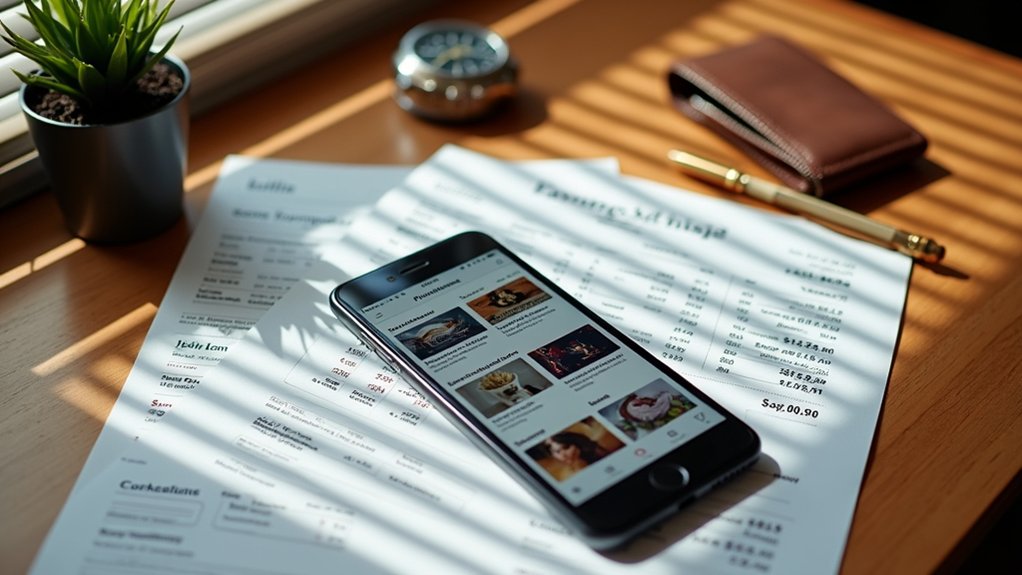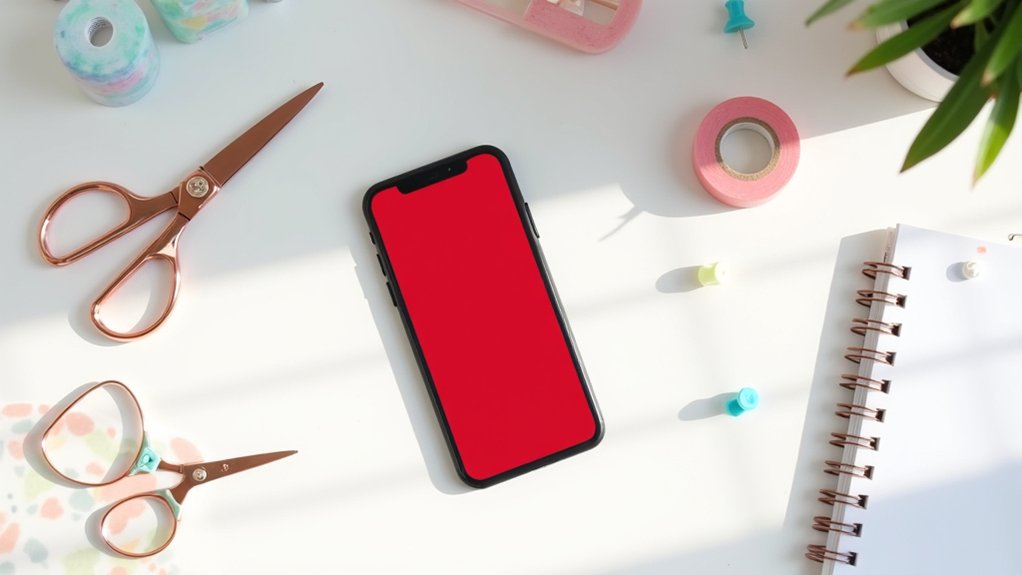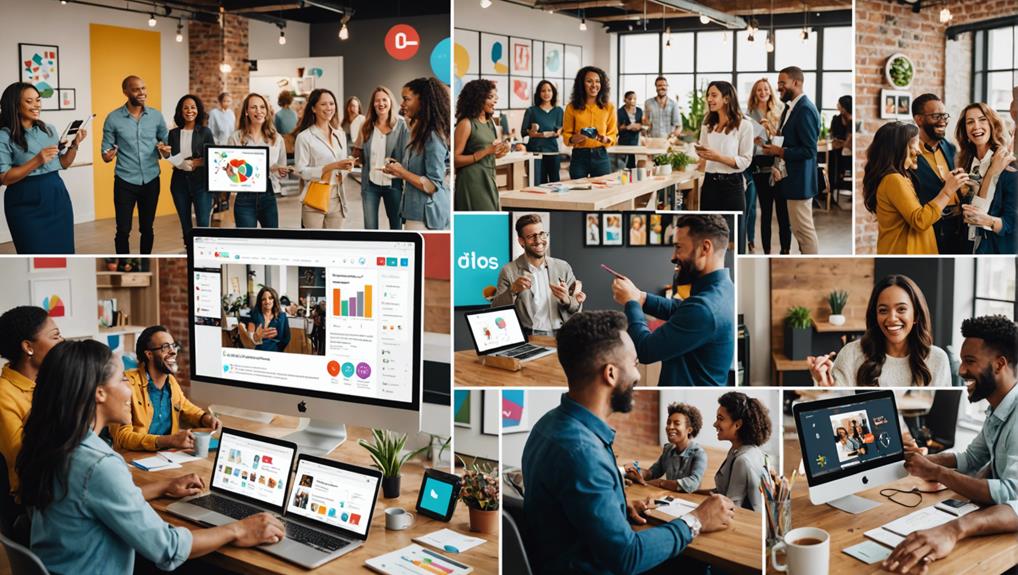To design eye-catching Pinterest pins that convert, start by understanding your audience through segmentation and Pinterest analytics. Use high-quality, vertical images with a 2:3 aspect ratio for the best display. Apply attractive color schemes and contrast, ensuring your text overlays are clear and concise using bold, readable fonts. Incorporate your brand's colors, fonts, and logos subtly to build recognition and trust. Craft compelling calls-to-action that highlight the benefits for users. Don't forget to incorporate your URL for added credibility. Monitor performance through Pinterest Analytics to refine and improve your designs. Dive deeper for more tips to enhance your pin strategy.
Key Takeaways
- Use a 2:3 aspect ratio with high-quality images for visually appealing pins.
- Employ bold, readable fonts and concise, keyword-rich text for better engagement.
- Integrate brand elements like colors, fonts, and logos for recognition and trust.
- Craft a compelling call-to-action using action-oriented language and urgent phrases.
- Regularly analyze performance metrics to optimize and identify top-performing pins.
Understand Your Audience
To create eye-catching pins, you've got to first immerse yourself in understanding your audience's unique tastes and behaviors. Engage in audience segmentation to categorize your followers based on their demographic insights and behavioral patterns. By analyzing these elements, you can craft pins that truly resonate.
Start by conducting thorough audience research. Use demographic insights to know who your audience is—age, gender, location, and more. Pinpoint what they're passionate about through interest analysis. Are they into DIY crafts, fashion, or culinary delights? Each segment will have different preferences, so understanding these nuances is essential.
Next, leverage Pinterest analytics to get a pulse on your current audience's engagement patterns. Which pins are they saving, sharing, or clicking on? This data offers a treasure trove of information about what they love and what they ignore. Utilize Pinterest Insights to track performance and audience behavior over time, enabling you to spot trends and adjust your strategy accordingly.
Tailor your pin designs to align with these preferences. A/B test different styles and formats to see what converts best. Your goal is to create pins that don't just catch the eye but also captivate the heart.
Optimal Pin Dimensions
Nailing the perfect pin dimensions begins with grasping Pinterest's sweet spot: a 2:3 aspect ratio at 1000 x 1500 pixels. This guarantees that your pins look crisp and engaging on both mobile and desktop screens.
Keep an eye on file size too; the right balance of resolution and clarity will make your pins pop and boost engagement.
Ideal Aspect Ratio
When designing Pinterest pins, delving into the ideal aspect ratio of 2:3 with dimensions of 1000 x 1500 pixels can be your secret weapon for capturing attention and driving engagement. This vertical layout not only optimizes visual space but also aligns perfectly with Pinterest's smart feed, giving your pins the best chance to stand out.
Let's explore some design tips and best practices to make the most of these dimensions.
Firstly, always keep your pins vertically oriented. Vertical pins naturally dominate the screen, making them more visually appealing and likely to be repinned. Next, use high-quality images that are sharp and clear. Blurry or pixelated images can turn users away.
Following that, ensure your text overlay is legible and contrasts well with the background. This helps convey your message quickly, even at a glance. Lastly, use a compelling call-to-action (CTA) to encourage users to click through.
Here's a quick checklist to keep your pins on point:
- Vertical orientation for maximum impact
- High-quality, sharp images
- Legible text with good contrast
- Clear and compelling call-to-action
Resolution and Clarity
Achieving perfect resolution and clarity in your Pinterest pins starts with following the ideal dimensions of 1000 x 1500 pixels. Sticking to this 2:3 aspect ratio guarantees your pins look sharp and professional on any device. When your pins are the right size, they're more likely to grab attention and drive engagement.
To make your pins stand out, focus on image composition and color schemes. Arrange your elements thoughtfully to guide the viewer's eye naturally across the pin. A balanced color palette not only enhances visual appeal but also strengthens brand recognition.
Incorporating principles of graphic design is essential. Utilize visual hierarchy to highlight the most important information first—whether it's a stunning image, a catchy headline, or an irresistible call-to-action. This means larger, bolder fonts for key text and strategic placement of images to create a flow that keeps viewers engaged.
File Size Recommendations
To guarantee your pins not only look stunning but also perform their best, it's important to follow Pinterest's recommended pin size of 1000 x 1500 pixels. This 2:3 aspect ratio ensures your pins are displayed effectively across all devices, grabbing users' attention whether they're on their phone or desktop.
Using the correct pin dimensions helps maintain the perfect balance between image compression and quality. You don't want your pins to look pixelated or blurry because that can deter potential followers. Instead, focus on creating high-quality images that retain their sharpness and clarity.
Additionally, mobile compatibility is crucial. Given that a significant number of Pinterest users scroll through their feed on mobile devices, ensuring your pins are correctly sized can make a big difference in user engagement and conversions.
Here are some key points to keep in mind:
- Adhere to the 1000 x 1500 pixels dimension for effective display.
- Balance image compression and quality to maintain clarity.
- Ensure mobile compatibility by sticking to recommended image sizing.
- Optimize your pins to catch users' attention and enhance performance.
High-Quality Visuals
For your pins to truly shine on Pinterest, high-resolution images are non-negotiable, ensuring every detail pops with clarity and professionalism. When users are scrolling through their feeds, you've got just a split second to grab their attention.
This is where color psychology and well-chosen graphic elements come into play. Bright, contrasting colors can evoke emotions and make your pins stand out, guiding the viewer's eye to the most important parts of your design.
Image editing tools like Canva or Adobe Spark are your best friends, even if you're not a graphic designer. These platforms offer templates and easy-to-use features that help you create visually appealing pins.
Pay close attention to visual hierarchy: your main message or product should be the focal point. This can be achieved by using larger fonts or bolder colors for key elements, ensuring they don't get lost in the design.
Effective Text Overlays
While high-quality visuals capture attention, effective text overlays seal the deal by delivering your message clearly and concisely. To make sure your text overlays are impactful, you need to focus on both content and design elements.
First, consider color psychology. Colors evoke emotions and can influence behavior. Use contrasting colors to make your text stand out against the background. For example, a bold white font on a dark background can be very eye-catching.
Next, pay attention to your font selection. Choose fonts that are bold and easily readable even at a glance. Avoid overly decorative fonts that might be hard to read. Instead, opt for clean, modern fonts that convey professionalism and clarity.
Your text should be short and relevant. A concise, powerful message will grab attention and increase engagement. Including keywords in your text overlays can also boost your pin's searchability on Pinterest, making it easier for users to find your content.
To sum up, keep these tips in mind:
- Use contrasting colors to enhance readability.
- Choose bold, readable fonts for clarity.
- Keep your message concise and to the point.
- Include relevant keywords to improve searchability.
Branding Elements
Incorporating brand elements like your colors, fonts, and logos into your pins not only boosts recognition but also builds trust with your audience. Start with logo placement. Your logo should be visible but not overpowering. Think bottom corners or subtle overlays—places that don't distract from your primary message.
Next, consider color psychology. Colors evoke emotions; choose hues that align with your brand's identity and message. Are you a wellness brand? Soft greens and blues can convey tranquility. A tech company? Bold reds and blacks might speak to innovation and energy.
Now, let's talk font selection. The fonts you choose should mirror your brand's personality. Sleek, modern fonts work well for contemporary brands, while elegant scripts might be better suited for luxury products. Consistency is key—use the same fonts across all your pins to create a cohesive look.
Don't forget website integration. Including your URL in your pin design subtly can drive traffic back to your site. It's a small touch, but it adds credibility and makes it easier for users to find you.
Multiple Pin Styles
Exploring multiple pin styles, like photo-based, graphic-based, and text-based designs, can help you discover what truly resonates with your audience. Start by experimenting with a mix of product images, lifestyle shots, and inspirational quotes. This variety will cater to different preferences and increase your engagement.
Delve into color psychology and current design trends to make sure your pins are visually appealing. Use a range of colors, fonts, and layouts to capture attention. For example, vibrant colors can evoke excitement, while muted tones might convey elegance.
A/B testing is essential in finding out which pin styles work best. Try different formats like carousel pins, video pins, and story pins. These dynamic elements can make your content more interactive and engaging.
Consider implementing these engagement strategies:
- Step-by-step tutorials: Offer actionable and valuable content.
- Infographics: Simplify complex information for easy understanding.
- Before-and-after visuals: Showcase transformations to captivate viewers.
- Inspirational quotes: Connect emotionally with your audience.
Strong Call-to-Action
Now, let's talk about crafting a strong call-to-action that commands attention.
Use action-oriented language and clear visual cues to guide your audience toward the next step.
Whether it's “Shop Now” or “Discover More,” your CTA should be the heartbeat of your pin.
Action-Oriented Language
Harness the power of action-oriented language to transform your pin titles and descriptions into compelling prompts that drive user engagement. By using engaging prompts and urgent phrases, you can create a sense of immediacy that encourages users to click.
Incorporate action verbs and compelling CTAs to make your pins irresistible. Action verbs like 'Discover,' 'Explore,' or 'Join' can turn a mundane description into an exciting invitation. These verbs not only convey what the user should do but also hint at the benefits they'll gain.
Urgent phrases like 'Limited Time Offer' or 'Don't Miss Out' can push users to act quickly, reducing the likelihood that they'll scroll past your pin.
To make your CTAs more compelling, be specific about what the user will achieve. Instead of just saying 'Click Here,' try 'Start Your Free Trial' or 'Download Your Guide.' Specificity adds value and makes the action seem more worthwhile.
Here's a quick rundown on how to make your CTAs pop:
- Use engaging prompts: Encourage users to take action with exciting language.
- Incorporate urgent phrases: Create a sense of urgency.
- Employ action verbs: Drive action with dynamic words.
- Be specific in your CTAs: Clearly state the benefit of taking action.
Clear Visual Cues
Incorporating clear visual cues like arrows or buttons in your pins will instantly draw attention to your call-to-action, making it pop and guiding users exactly where you want them to go.
When you leverage visual hierarchy and design principles, you can strategically position these graphic elements to maximize their effectiveness. Use contrasting colors to make your call-to-action stand out, ensuring it's easily noticeable even at a glance.
Animated elements like GIFs or moving arrows are fantastic attention-grabbing techniques that can further enhance the visibility of your call-to-action. These dynamic touches can make your pin more engaging and interactive, encouraging users to take the desired action.
Position your call-to-action strategically on the pin, making sure it's easily accessible and prominent. Experiment with different placements and designs to find what works best for your audience. By testing various arrangements, you can uncover the most effective combination that boosts conversions.
Analyze Performance
To truly make your pins stand out, you'll need to dive deep into analyzing their performance through key metrics like impressions, clicks, saves, and engagements. Use Pinterest Analytics to uncover which pins are driving the most traffic and conversions. This data isn't just numbers; it's the roadmap to refining your pin design and conversion tracking strategies.
Start by identifying trends in your top-performing pins. Are there common elements in the design that attract more clicks? Does a particular type of content get more saves? Understanding these patterns will guide your future content and design choices.
Regularly monitor your conversion rates to see which design elements resonate most with your audience. It's not just about how many people see your pin, but how many take action because of it. Continually review and adjust your strategies based on performance data to keep your pins engaging and effective.
Here's a quick checklist to keep in mind:
- Impressions: Number of times your pin appears on users' screens.
- Clicks: How often users click on your pin.
- Saves: Frequency of users saving your pin to their boards.
- Engagements: Overall interaction with your pin, including clicks, saves, and comments.
Frequently Asked Questions
How to Create Pins That Convert?
You can create pins that convert by leveraging color psychology and design templates. Choose high-quality images, bold text overlays, and a vertical 2:3 aspect ratio. Experiment with designs and include clear calls to action for engagement.
How to Create Eye Catching Pins?
To create eye-catching pins, use color psychology to evoke emotions and high image resolution for crisp visuals. Bold colors grab attention, while clear text overlays and consistent branding guarantee your pins stand out in the Pinterest feed.
How to Create Effective Pinterest Pins?
Maintain brand consistency and keyword optimization in your Pinterest pins. Utilize high-quality images and bold text overlays. Explore different styles, colors, and fonts. Create engaging titles and descriptions that connect with your audience for improved conversions.
How Do You Make Good Looking Pins?
To create good-looking pins, use vibrant color schemes and clear typography choices. Select high-quality images and bold fonts. Consistently incorporate your brand's colors, logos, and fonts. Experiment with designs to see what your audience loves.
Conclusion
You've got the tools to design eye-catching pins that convert! Understand your audience, nail the best pin dimensions, and always use high-quality visuals.
Don't forget effective text overlays and consistent branding elements. Experiment with multiple pin styles and include a strong call-to-action.
Finally, keep analyzing performance to tweak and perfect your strategy. With these tips, your pins won't only grab attention but also drive engagement and conversions.
Now, go create pins that stand out!




